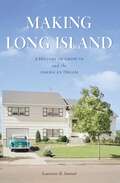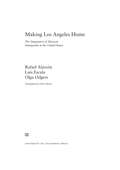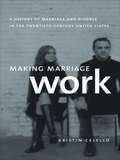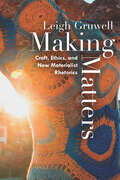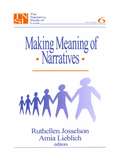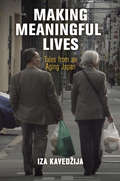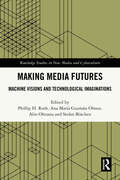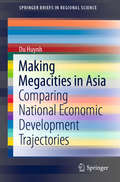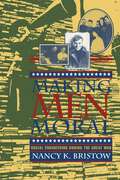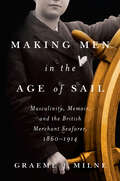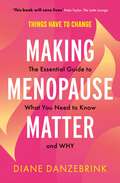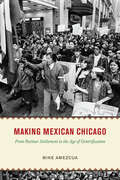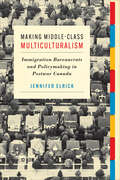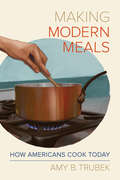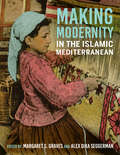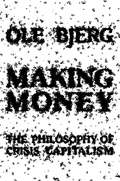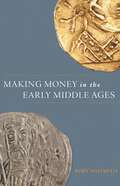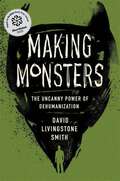- Table View
- List View
Making Long Island: A History of Growth and the American Dream (The History Press)
by Lawrence R. SamuelDiscover the history of the development of Long Island and its intimate relationship with New York City. Beginning in the Roaring Twenties, Wall Street money looked eastward to Nassau and Suffolk counties looking generate wealth from a land boom. After the Great Depression and World War II, Long Island was the site of the creation of the quintessential postwar American suburb, Levittown. Levittown and its spinoff suburban communities served as a primary symbol of the American dream through affordable home ownership for the predominately White middle class and established a core attribute of the national mythology. Starting in the 1960s, the dream began to dissolve, as the postwar economic engine ran out of steam and Long Island became as much urban as suburban. Author Lawrence R. Samuel charts how the island evolved over the decades and largely detached itself from New York City to become a self-sustaining entity with its own challenges, exclusions and triumphs.
Making Los Angeles Home: The Integration of Mexican Immigrants in the United States
by Rafael Alarcón Luis Escala Olga OdgersMaking Los Angeles Home examines the different integration strategies implemented by Mexican immigrants in the Los Angeles region. Relying on statistical data and ethnographic information, the authors analyze four different dimensions of the immigrant integration process (economic, social, cultural, and political) and show that there is no single path for its achievement, but instead an array of strategies that yield different results. However, their analysis also shows that immigrants' successful integration essentially depends upon their legal status and long residence in the region. The book shows that, despite this finding, immigrants nevertheless decide to settle in Los Angeles, the place where they have made their homes.
Making Love with the Land: Essays
by Joshua WhiteheadA moving and deeply personal excavation of Indigenous beauty and passion in a suffering world The novel Jonny Appleseed established Joshua Whitehead as one of the most exciting and important new literary voices on Turtle Island, winning both a Lambda Literary Award and Canada Reads 2021. In Making Love with the Land, his first nonfiction book, Whitehead explores the relationships between body, language, and land through creative essay, memoir, and confession.In prose that is evocative and sensual, unabashedly queer and visceral, raw and autobiographical, Whitehead writes of an Indigenous body in pain, coping with trauma. Deeply rooted within, he reaches across the anguish to create a new form of storytelling he calls &“biostory&”—beyond genre, and entirely sovereign. Through this narrative perspective, Making Love with the Land recasts mental health struggles and our complex emotional landscapes from a nefarious parasite on his (and our) well-being to kin, even a relation, no matter what difficulties they present to us. Whitehead ruminates on loss and pain without shame or ridicule but rather highlights waypoints for personal transformation. Written in the aftermath of heartbreak, before and during the pandemic, Making Love with the Land illuminates this present moment in which both Indigenous and non-Indigenous people are rediscovering old ways and creating new ones about connection with and responsibility toward each other and the land.Intellectually audacious and emotionally compelling, Whitehead shares his devotion to the world in which we live and brilliantly—even joyfully—maps his experience on the land that has shaped stories, histories, and bodies from time immemorial.
Making Marie Curie: Intellectual Property and Celebrity Culture in an Age of Information
by Eva Hemmungs WirténIn many ways, Marie Curie represents modern science. Her considerable lifetime achievements--the first woman to be awarded a Nobel Prize, the only woman to be awarded the Prize in two fields, and the only person to be awarded Nobel Prizes in multiple sciences--are studied by schoolchildren across the world. When, in 2009, the New Scientist carried out a poll for the "Most Inspirational Female Scientist of All Time," the result was a foregone conclusion: Marie Curie trounced her closest runner-up, Rosalind Franklin, winning double the number of Franklin's votes. She is a role model to women embarking on a career in science, the pride of two nations--Poland and France--and, not least of all, a European Union brand for excellence in science. Making Marie Curie explores what went into the creation of this icon of science. It is not a traditional biography, or one that attempts to uncover the "real" Marie Curie. Rather, Eva Hemmungs Wirtén, by tracing a career that spans two centuries and a world war, provides an innovative and historically grounded account of how modern science emerges in tandem with celebrity culture under the influence of intellectual property in a dawning age of information. She explores the emergence of the Curie persona, the information culture of the period that shaped its development, and the strategies Curie used to manage and exploit her intellectual property. How did one create and maintain for oneself the persona of scientist at the beginning of the twentieth century? What special conditions bore upon scientific women, and on married women in particular? How was French identity claimed, established, and subverted? How, and with what consequences, was a scientific reputation secured? In its exploration of these questions and many more, Making Marie Curie provides a composite picture not only of the making of Marie Curie, but the making of modern science itself.
Making Markets Making Place: Geography, Topo/graphy and the Reproduction of an Urban Marketplace
by Benjamin ColesThis book examines place and place-making in London’s Borough Market. In particular, it uses topo/graphy (‘place-writing) to interrogate the ways in which Borough Market’s material, social-sensual and discursive relations assemble to reproduce Borough Market as a place, market and marketplace. Its central premise is that market-processes – the negotiation and exchange of commodities –are place-processes. This means that the often-abstract relationships that ultimately define what we think of as the economy are embedded in the rich and every materiality, sociality, sensuality and meanings associated with place. By tracing out these different elements, topo/graphy illustrates the ways in which economic reproduction is grounded in particular and often discrete practices. However, by assembling them together, this highlights the ways in which place and place-making are the driving force behind the economy at large.
Making Marriage Work: A History of Marriage and Divorce in the Twentieth-Century United States
by Kristin CelelloBy the end of World War I, the skyrocketing divorce rate in the United States had generated a deep-seated anxiety about marriage. This fear drove middle-class couples to seek advice, both professional and popular, in order to strengthen their relationships. InMaking Marriage Work, historian Kristin Celello offers an insightful and wide-ranging account of marriage and divorce in America in the twentieth century, focusing on the development of the idea of marriage as "work. " Examining the marriage counseling profession, advice columns in women's magazines, movies, and television shows, Celello describes how professionals and the public worked together to define the nature of marital work throughout the twentieth century. She also demonstrates that the maxim of "working at marriage" often masked important inequalities in regard to men's and women's roles within marriage. Most experts, for instance, assumed that women needed marriage more than men and thus held wives accountable for marital success or failure. Making Marriage Workpresents a new interpretation of married life in the United States, illuminating the interaction of marriage and divorce over the century and revealing how the idea that marriage requires work became part of Americans' collective consciousness.
Making Matters: Craft, Ethics, and New Materialist Rhetorics
by Leigh GruwellCraft is a process-oriented practice that takes seriously the relationships between bodies—both human and nonhuman—and makes apparent how these relationships are mired in and informed by power structures. Making Matters introduces craft agency, a feminist vision of new materialist rhetorics that enables scholars to identify how power circulates and sometimes stagnates within assemblages of actors and provides tools to rectify that uneven distribution. To recast new materialist rhetorics as inherently crafty, Leigh Gruwell historicizes and locates the concept of craft both within rhetorical history as well as in the disciplinary history of writing studies. Her investigation centers on three specific case studies: craftivism, the fibercraft website Ravelry, and the 2017 Women’s March. These instances all highlight how a material, ecological understanding of rhetorical agency can enact political change. Craft agency models how we humans might work with and alongside things—nonhuman, sometimes digital, sometimes material—to create more equitable relationships. Making Matters argues that craft is a useful starting point for addressing criticisms of new materialist rhetorics not only because doing so places rhetorical action as a product of complex relationships between a network of human and nonhuman actors, but also because it does so with an explicitly activist agenda that positions the body itself as a material interface.
Making Meaning of Narratives
by Dr Ruthellen H. Josselson Dr Amia LieblichThe sixth volume in this series provides: guides for doing qualitative research; analysis of several autobiographies; hints on how to interpret what is not said in narrative interviews; discussion on how cultural meanings and values are transmitted across generations; and illustrations of the transformational power of stories.
Making Meaningful Lives: Tales from an Aging Japan (Contemporary Ethnography)
by Iza KavedžijaWhat makes for a meaningful life? In the Japanese context, the concept of ikigai provides a clue. Translated as "that which makes one's life worth living," ikigai has also come to mean that which gives a person happiness. In Japan, where the demographic cohort of elderly citizens is growing, and new modes of living and relationships are revising traditional multigenerational family structures, the elderly experience of ikigai is considered a public health concern. Without a relevant model for meaningful and joyful older age, the increasing older population of Japan must create new cultural forms that center the ikigai that comes from old age.In Making Meaningful Lives, Iza Kavedžija provides a rich anthropological account of the lives and concerns of older Japanese women and men. Grounded in years of ethnographic fieldwork at two community centers in Osaka, Kavedžija offers an intimate narrative analysis of the existential concerns of her active, independent subjects. Alone and in groups, the elderly residents of these communities make sense of their lives and shifting ikigai with humor, conversation, and storytelling. They are as much providers as recipients of care, challenging common images of the elderly as frail and dependent, while illustrating a more complex argument: maintaining independence nevertheless requires cultivating multiple dependences on others. Making Meaningful Lives argues that an anthropology of the elderly is uniquely suited to examine the competing values of dependence and independence, sociality and isolation, intimacy and freedom, that people must balance throughout all of life's stages.
Making Media Futures: Machine Visions and Technological Imaginations (Routledge Studies in New Media and Cyberculture)
by Alin Olteanu Stefan Böschen Phillip H. Roth Ana María Guzmán OlmosMaking Media Futures offers a multi-perspectival exploration of how imaginaries and knowledge of the future are constructed in and through various media.The volume addresses the discursive dimensions of imaginaries and future visions as well as the impact of technological, material, and cultural conditions on the propagation of future discourses through media. Providing both theoretically detailed and empirically rich investigations, the contributions offer a wide range of cases spanning the century from the end of World War II until today and looking at examples from the Southern Hemisphere as well as the Global North. Bringing together scholars in media studies, science and technology studies (STS), and the history and philosophy of technology, the chapters discuss future visions and imaginations of quantum computing, the uncertainty and impact of AI-based text-to-image generation, the ideology behind 5G telecommunication standards, imaginaries of the Internet of Things, transmedia strategies in global and local climate protests, how broadcast radio was implicated in the evangelical mission imaginary, and how early visions of automating scholarly information management shaped standards and ideals of academia. The volume thus complements existing approaches and analytical frameworks for the study of imaginaries and futures discourses with perspectives that are sensitive to the plurality of media-specific conditions and technologies.The book will interest students and scholars working in media studies, STS, history and philosophy as well as at the intersection of engineering, humanities and social sciences, on matters such as sustainability, ethics, and responsible innovation.
Making Media Matter: Critical Literacy, Popular Culture, and Creative Production
by Benjamin TheveninThis book is an essential resource for media educators working to promote critical thinking, creativity, and civic engagement through their teaching. Connecting theory and research with creative projects and analyses of pop culture, it models an integrated and practical approach to media education. In order to prepare learners to successfully navigate rapid shifts in digital technology and popular culture, media educators in both secondary and university settings need to develop fresh, innovative approaches. Integrating concepts and practices from the fields of media studies, media arts, and media literacy, this book prepares teachers to help their students make connections between their studies, uses of media, creative expression, and political participation. As educators implement the strategies in this book in their curricula and pedagogy, they will be empowered to help their students more thoughtfully engage with media culture and use their intelligence and imagination to address pressing challenges facing our world today. Making Media Matter is an engaging and accessible read for educators and scholars in the areas of media literacy, media and cultural studies, media arts, and communication studies.
Making Megacities in Asia: Comparing National Economic Development Trajectories (SpringerBriefs in Regional Science)
by Du HuynhThis book analyses and compares the development paths of five major cities in East and Southeast Asia since the early 1960s, including Ho Chi Minh City, Jakarta, Manila, Seoul, and Shanghai. In examining these five cases through a carefully crafted conceptual framework, the author excavates an understanding of the dynamics that have enabled Seoul and Shanghai to become highly competitive as major engines of economic growth, while simultaneously accounting for why the other three cities have faced numerous problems in terms of meeting their development goals. Presenting both quantitative and qualitative data to trace the course of changes between 1960 and 2015, the case studies curate six possible explanations for the different cities’ developmental trajectories. The book considers the national development strategy matters to the development of cities and positions the share of budget revenue retained for cities’ expenditure as critical. The author demonstrates that consistently pursuing long-term strategies is important, and that public entrepreneurship with powerful supporting coalitions is vital. The book illustrates how master plans have played limited roles in the building of cities, and that fragmented governments are often at the root of the problems facing a city’s development. This book will be highly relevant to researchers in international and Asian urban development.
Making Men Moral: Social Engineering During the Great War (The American Social Experience #8)
by Nancy K. BristowOn May 29, 1917, Mrs. E. M. Craise, citizen of Denver, Colorado, penned a letter to President Woodrow Wilson, which concluded, We have surrendered to your absolute control our hearts' dearest treasures--our sons. If their precious bodies that have cost us so dear should be torn to shreds by German shot and shells we will try to live on in the hope of meeting them again in the blessed Country of happy reunions. But, Mr. President, if the hell-holes that infest their training camps should trip up their unwary feet and they be returned to us besotted degenerate wrecks of their former selves cursed with that hell-born craving for alcohol, we can have no such hope. Anxious about the United States' pending entry into the Great War, fearful that their sons would be polluted by the scourges of prostitution, venereal disease, illicit sex, and drink that ran rampant in the training camps, countless Americans sent such missives to their government officials. In response to this deluge, President Wilson created the Commission on Training Camp Activities to ensure the purity of the camp environment. Training camps would henceforth mold not only soldiers, but model citizens who, after the war, would return to their communities, spreading white, urban, middle-class values throughout the country. What began as a federal program designed to eliminate sexually transmitted diseases soon mushroomed into a powerful social force intent on replacing America's many cultures with a single, homogenous one. Though committed to the positive methods of education and recreation, the reformers did not hesitate to employ repression when necessary. Those not conforming to the prescribed vision of masculinity often faced exclusion from the reformers' idealized society, or sometimes even imprisonment. Social engineering ruled the day. Combining social, cultural, and military history and illustrating the deep divisions among reformers themselves, Nancy K. Bristow, with the aid of dozens of evocative photographs, here brings to life a pivotal era in the history of the U.S., revealing the complex relationship between the nation's competing cultures, progressive reform efforts, and the Great War.
Making Men in the Age of Sail: Masculinity, Memoir, and the British Merchant Seafarer, 1860–1914
by Graeme J. MilneMyths and stereotypes surrounding seafarers in the Age of Sail persist to this day. Sailors were celebrated for their courage, strength, and skill, yet condemned for militancy, vice, and fecklessness. As sail gave way to steam, sailing-ship mariners became nostalgic symbols of maritime prowess and heritage, representing a timeless, heroic masculinity in an era when the modernizing industrial world was challenging assumptions about gender, class, work, and society.Drawing on British seafaring memoirs from the late nineteenth century, Making Men in the Age of Sail argues that maritime writing moulded the reading public’s image of the merchant seaman. Authors chronicled their lives as they grew from boy sailors to trained seafarers, telling colourful tales of the men they worked with – most never doubted that the sailing ship had made them better men. Their testimony reinforced and preserved conservative perspectives on seafaring manhood as Britain’s economic and technological priorities continued to evolve in the new steamship age.Offering a gender analysis of the image of the seafarer, Making Men in the Age of Sail brings the history of British sailors into wider debates about modernity and masculinity.
Making Menopause Matter: The Essential Guide to What You Need to Know and Why
by Diane DanzebrinkIn recent years, the conversation around menopause has opened up; most of us understand what menopause means, and that it can be more than a few hot flushes and periods stopping. BUT.Do we really know why menopause matters?Menopause will directly affect approximately half the world's population, and will indirectly affect the other half, too. There is a huge diversity of experiences that can potentially impact both short- and long-term physical, cognitive and emotional health and wellbeing, careers, relationships, families, friendships and finances. How do you, your mother, your sister, your friends or your partner get the help and support that they need in all aspects of their lives, throughout the menopause transition and beyond? Diane's book can answer that - and so much more. Diane Danzebrink was one of the first people to campaign for better menopause education, care, and support. Her work has been critical in ensuring that menopause is now part of the RSE curriculum in schools in England, and to the way in which menopause is no longer seen as a shameful or trivial experience. Her book, Making Menopause Matter, guides us through all aspects of the menopause landscape; it reminds us not only of what menopause is - its scope, nature and potential impact - but also why it is important that we continue to call for access to support for all, enhanced understanding, and an acceptance that menopause is an individual experience. While it may not be a seamless transition, menopause does offer an important opportunity when the right help and support is in place. Diane's wise, compassionate writing offers practical advice along with deeper insights into how we can better support ourselves and those we know and love when their lives are impacted by menopause. Part manifesto, a little memoir, plenty of self-help and ultimately a call to arms for society, public health and individuals alike, Making Menopause Matter should be required reading for all.
Making Mexican Chicago: From Postwar Settlement to the Age of Gentrification (Historical Studies of Urban America)
by Mike AmezcuaAn exploration of how the Windy City became a postwar Latinx metropolis in the face of white resistance. Though Chicago is often popularly defined by its Polish, Black, and Irish populations, Cook County is home to the third-largest Mexican-American population in the United States. The story of Mexican immigration and integration into the city is one of complex political struggles, deeply entwined with issues of housing and neighborhood control. In Making Mexican Chicago, Mike Amezcua explores how the Windy City became a Latinx metropolis in the second half of the twentieth century. In the decades after World War II, working-class Chicago neighborhoods like Pilsen and Little Village became sites of upheaval and renewal as Mexican Americans attempted to build new communities in the face of white resistance that cast them as perpetual aliens. Amezcua charts the diverse strategies used by Mexican Chicagoans to fight the forces of segregation, economic predation, and gentrification, focusing on how unlikely combinations of social conservatism and real estate market savvy paved new paths for Latinx assimilation. Making Mexican Chicago offers a powerful multiracial history of Chicago that sheds new light on the origins and endurance of urban inequality.
Making Mexican Chicago: From Postwar Settlement to the Age of Gentrification (Historical Studies of Urban America)
by Mike AmezcuaAn exploration of how the Windy City became a postwar Latinx metropolis in the face of white resistance. Though Chicago is often popularly defined by its Polish, Black, and Irish populations, Cook County is home to the third-largest Mexican-American population in the United States. The story of Mexican immigration and integration into the city is one of complex political struggles, deeply entwined with issues of housing and neighborhood control. In Making Mexican Chicago, Mike Amezcua explores how the Windy City became a Latinx metropolis in the second half of the twentieth century. In the decades after World War II, working-class Chicago neighborhoods like Pilsen and Little Village became sites of upheaval and renewal as Mexican Americans attempted to build new communities in the face of white resistance that cast them as perpetual aliens. Amezcua charts the diverse strategies used by Mexican Chicagoans to fight the forces of segregation, economic predation, and gentrification, focusing on how unlikely combinations of social conservatism and real estate market savvy paved new paths for Latinx assimilation. Making Mexican Chicago offers a powerful multiracial history of Chicago that sheds new light on the origins and endurance of urban inequality.
Making Middle-Class Multiculturalism: Immigration Bureaucrats and Policymaking in Postwar Canada
by Jennifer ElrickIn the 1950s and 1960s, immigration bureaucrats in the Department of Citizenship and Immigration played an important yet unacknowledged role in transforming Canada’s immigration policy. In response to external economic and political pressures for change, high-level bureaucrats developed new admissions criteria gradually and experimentally while personally processing thousands of individual immigration cases per year. Making Middle-Class Multiculturalism shows how bureaucrats’ perceptions and judgements about the admissibility of individuals – in socioeconomic, racial, and moral terms – influenced the creation of formal admissions criteria for skilled workers and family immigrants that continue to shape immigration to Canada. A qualitative content analysis of archival documents, conducted through the theoretical lens of a cultural sociology of immigration policy, reveals that bureaucrats’ interpretations of immigration files generated selection criteria emphasizing not just economic utility, but also middle-class traits and values such as wealth accumulation, educational attainment, entrepreneurial spirit, resourcefulness, and a strong work ethic. By making "middle-class multiculturalism" a demographic reality and basis of nation-building in Canada, these state actors created a much-admired approach to managing racial diversity that has nevertheless generated significant social inequalities.
Making Moderate Islam: Sufism, Service, and the "Ground Zero Mosque" Controversy
by Rosemary CorbettDrawing on a decade of research into the community that proposed the so-called "Ground Zero Mosque," this book refutes the idea that current demands for Muslim moderation have primarily arisen in response to the events of 9/11, or to the violence often depicted in the media as unique to Muslims. Instead, it looks at a century of pressures on religious minorities to conform to dominant American frameworks for race, gender, and political economy. These include the encouraging of community groups to provide social services to the dispossessed in compensation for the government's lack of welfare provisions in an aggressively capitalist environment. Calls for Muslim moderation in particular are also colored by racist and orientalist stereotypes about the inherent pacifism of Sufis with respect to other groups. The first investigation of the assumptions behind moderate Islam in our country, Making Moderate Islam is also the first to look closely at the history, lives, and ambitions of the those involved in Manhattan's contested project for an Islamic community center.
Making Modern Meals: How Americans Cook Today
by Amy B. TrubekHome cooking is crucial to our lives, but today we no longer identify it as an obligatory everyday chore. By looking closely at the stories and practices of contemporary American home cooks—witnessing them in the kitchen and at the table—Amy B. Trubek reveals our episodic but also engaged relationship to making meals. Making Modern Meals explores the state of American cooking over the past century and across all its varied practices, whether cooking is considered a chore, a craft, or a creative process. Trubek challenges current assumptions about who cooks, who doesn’t, and what this means for culture, cuisine, and health. She locates, identifies, and discusses the myriad ways Americans cook in the modern age, and in doing so, argues that changes in making our meals—from shopping to cooking to dining—have created new cooks, new cooking categories, and new culinary challenges.
Making Modern Mothers: Ethics and Family Planning in Urban Greece
by Heather PaxsonIn Greece, women speak of mothering as "within the nature" of a woman. But this durable association of motherhood with femininity exists in tension with the highest incidence of abortion and one of the lowest fertility rates in Europe. In this setting, how do women think of themselves as proper individuals, mothers, and Greek citizens? In this anthropological study of reproductive politics and ethics in Athens, Greece, Heather Paxson tracks the effects of increasing consumerism and imported biomedical family planning methods, showing how women's "nature" is being transformed to meet crosscutting claims of the contemporary world. Locating profound ambivalence in people's ethical evaluations of gender and fertility control, Paxson offers a far-reaching analysis of conflicting assumptions about what it takes to be a good mother and a good woman in modern Greece, where assertions of cultural tradition unfold against a backdrop of European Union integration, economic struggle, and national demographic anxiety over a falling birth rate.
Making Modernity in the Islamic Mediterranean
by Marcus Milwright Peter Christensen Ünver Rüstem Gülru Çakmak Hala Auji Emily Neumeier Jessica Gerschultz Ashley Dimmig David J. RoxburghThe Islamic world's artistic traditions experienced profound transformation in the 19th century as rapidly developing technologies and globalizing markets ushered in drastic changes in technique, style, and content. Despite the importance and ingenuity of these developments, the 19th century remains a gap in the history of Islamic art. To fill this opening in art historical scholarship, Making Modernity in the Islamic Mediterranean charts transformations in image-making, architecture, and craft production in the Islamic world from Fez to Istanbul. Contributors focus on the shifting methods of production, reproduction, circulation, and exchange artists faced as they worked in fields such as photography, weaving, design, metalwork, ceramics, and even transportation. Covering a range of media and a wide geographical spread, Making Modernity in the Islamic Mediterranean reveals how 19th-century artists in the Middle East and North Africa reckoned with new tools, materials, and tastes from local perspectives.
Making Money
by Ole BjergWhat is money? Where does it come from? Who makes our money today? And how can we understand the current state of our economy as a crisis of money itself? In Making Money, Ole Bjerg turns these questions into a matter of philosophical rather than economic analysis. Using the thinking of Slavoj i ek, while still engaging with mainstream economic literature, the book provides a genuinely philosophical theory of money. This theory is unfolded in reflections on the nature of monetary phenomenon such as financial markets, banks, debt, credit, derivatives, gold, risk, value, price, interests, and arbitrage. The analysis of money is put into an historical context by suggesting that the current financial turbulence and debt crisis are symptoms that we live in the age of post-credit capitalism. By bridging the fields of economics and contemporary philosophy, Bjerg's work engages in a productive form of intellectual arbitrage.From the Trade Paperback edition.
Making Money in the Early Middle Ages
by Rory NaismithAn examination of coined money and its significance to rulers, aristocrats and peasants in early medieval EuropeBetween the end of the Roman Empire in the fifth century and the economic transformations of the twelfth, coined money in western Europe was scarce and high in value, difficult for the majority of the population to make use of. And yet, as Rory Naismith shows in this illuminating study, coined money was made and used throughout early medieval Europe. It was, he argues, a powerful tool for articulating people’s place in economic and social structures and an important gauge for levels of economic complexity. Working from the premise that using coined money carried special significance when there was less of it around, Naismith uses detailed case studies from the Mediterranean and northern Europe to propose a new reading of early medieval money as a point of contact between economic, social, and institutional history.Naismith examines structural issues, including the mining and circulation of metal and the use of bullion and other commodities as money, and then offers a chronological account of monetary development, discussing the post-Roman period of gold coinage, the rise of the silver penny in the seventh century and the reconfiguration of elite power in relation to coinage in the tenth and eleventh centuries. In the process, he counters the conventional view of early medieval currency as the domain only of elite gift-givers and intrepid long-distance traders. Even when there were few coins in circulation, Naismith argues, the ways they were used—to give gifts, to pay rents, to spend at markets—have much to tell us.
Making Monsters: The Uncanny Power of Dehumanization
by David Livingstone SmithA leading scholar explores what it means to dehumanize others—and how and why we do it. “I wouldn’t have accepted that they were human beings. You would see an infant who’s just learning to smile, and it smiles at you, but you still kill it.” So a Hutu man explained to an incredulous researcher, when asked to recall how he felt slaughtering Tutsis in Rwanda in 1994. Such statements are shocking, yet we recognize them; we hear their echoes in accounts of genocides, massacres, and pogroms throughout history. How do some people come to believe that their enemies are monsters, and therefore easy to kill? In Making Monsters David Livingstone Smith offers a poignant meditation on the philosophical and psychological roots of dehumanization. Drawing on harrowing accounts of lynchings, Smith establishes what dehumanization is and what it isn’t. When we dehumanize our enemy, we hold two incongruous beliefs at the same time: we believe our enemy is at once subhuman and fully human. To call someone a monster, then, is not merely a resort to metaphor—dehumanization really does happen in our minds. Turning to an abundance of historical examples, Smith explores the relationship between dehumanization and racism, the psychology of hierarchy, what it means to regard others as human beings, and why dehumanizing others transforms them into something so terrifying that they must be destroyed. Meticulous but highly readable, Making Monsters suggests that the process of dehumanization is deeply seated in our psychology. It is precisely because we are all human that we are vulnerable to the manipulations of those trading in the politics of demonization and violence.
